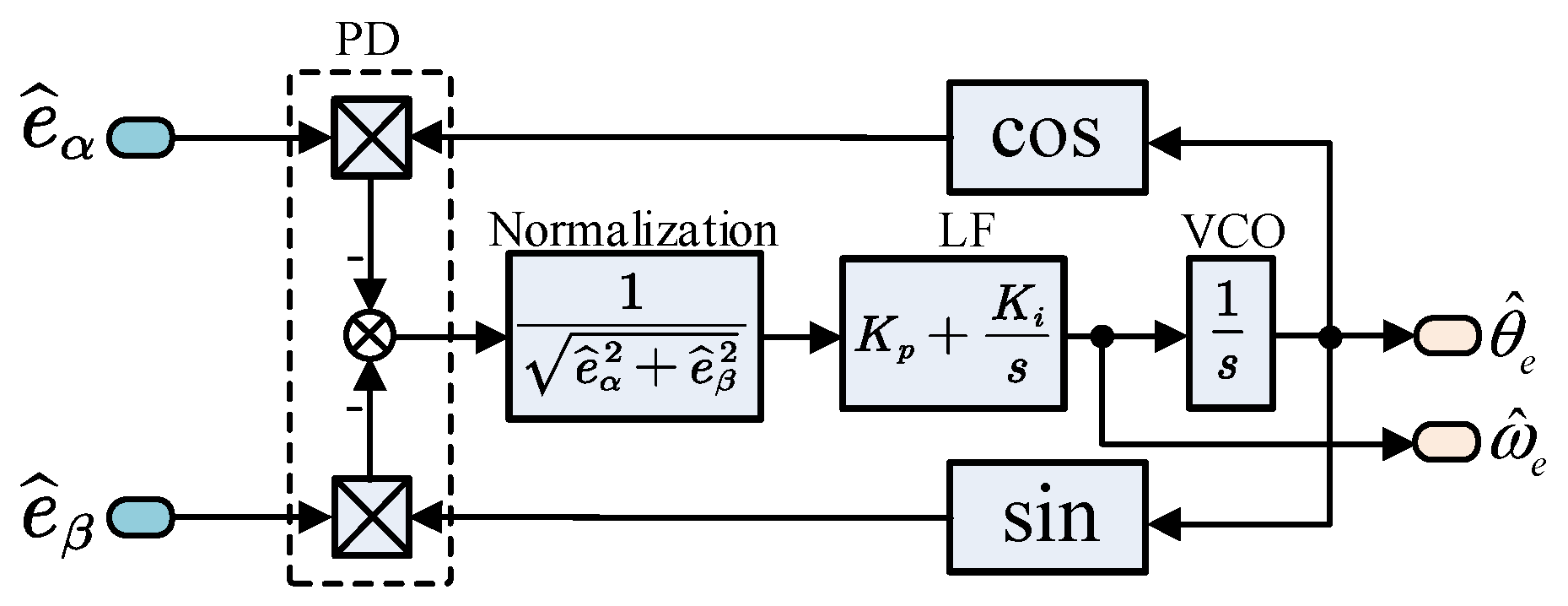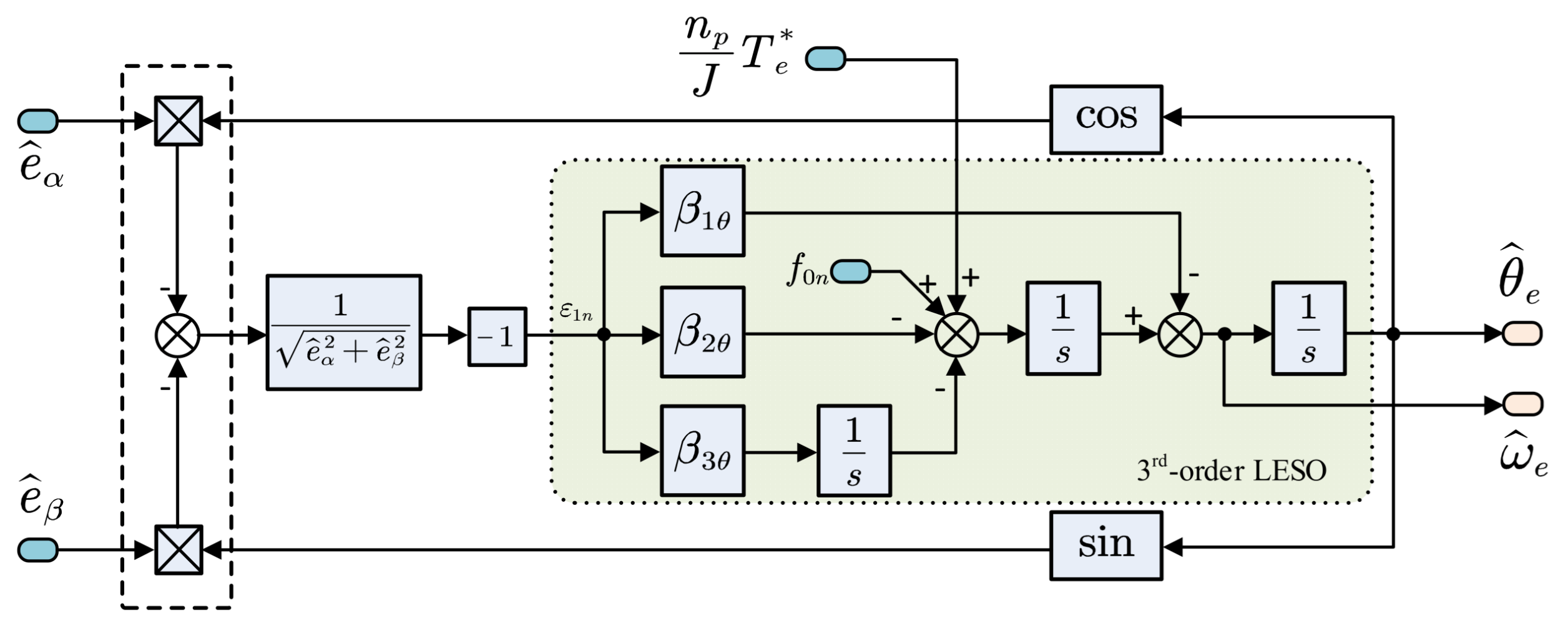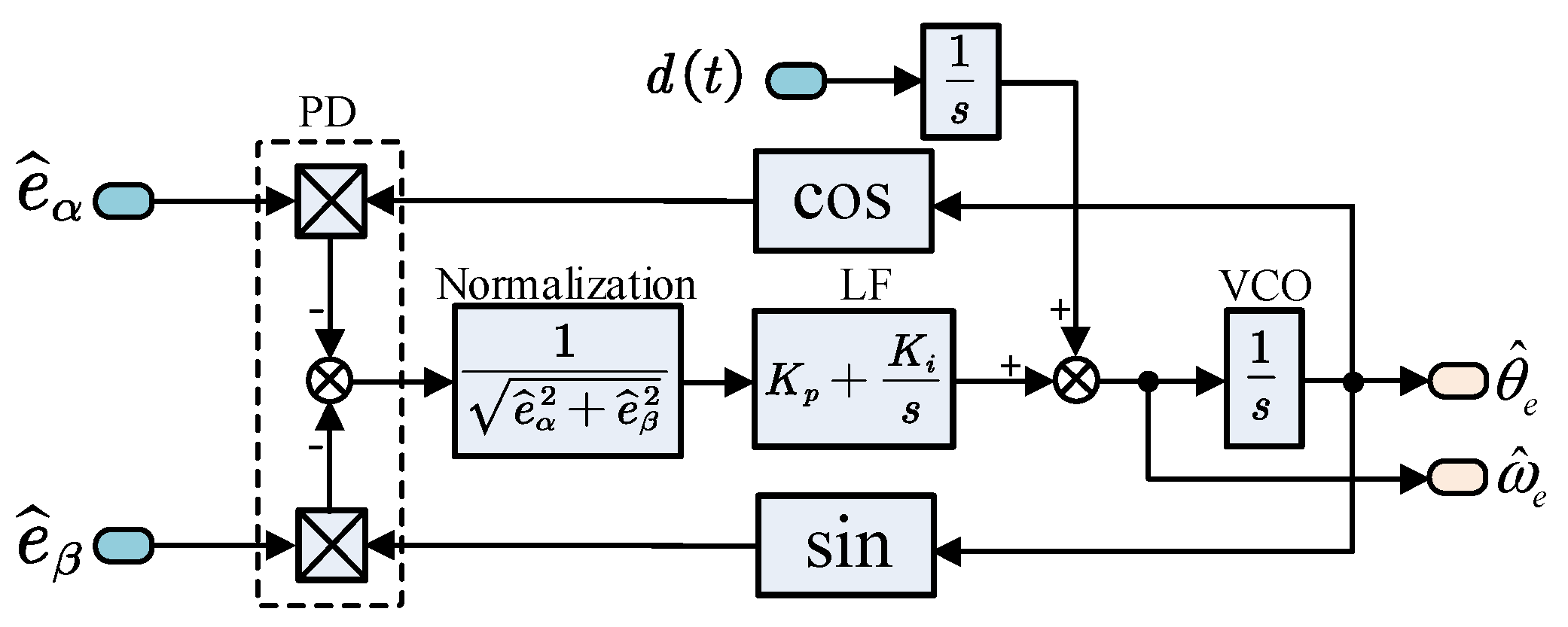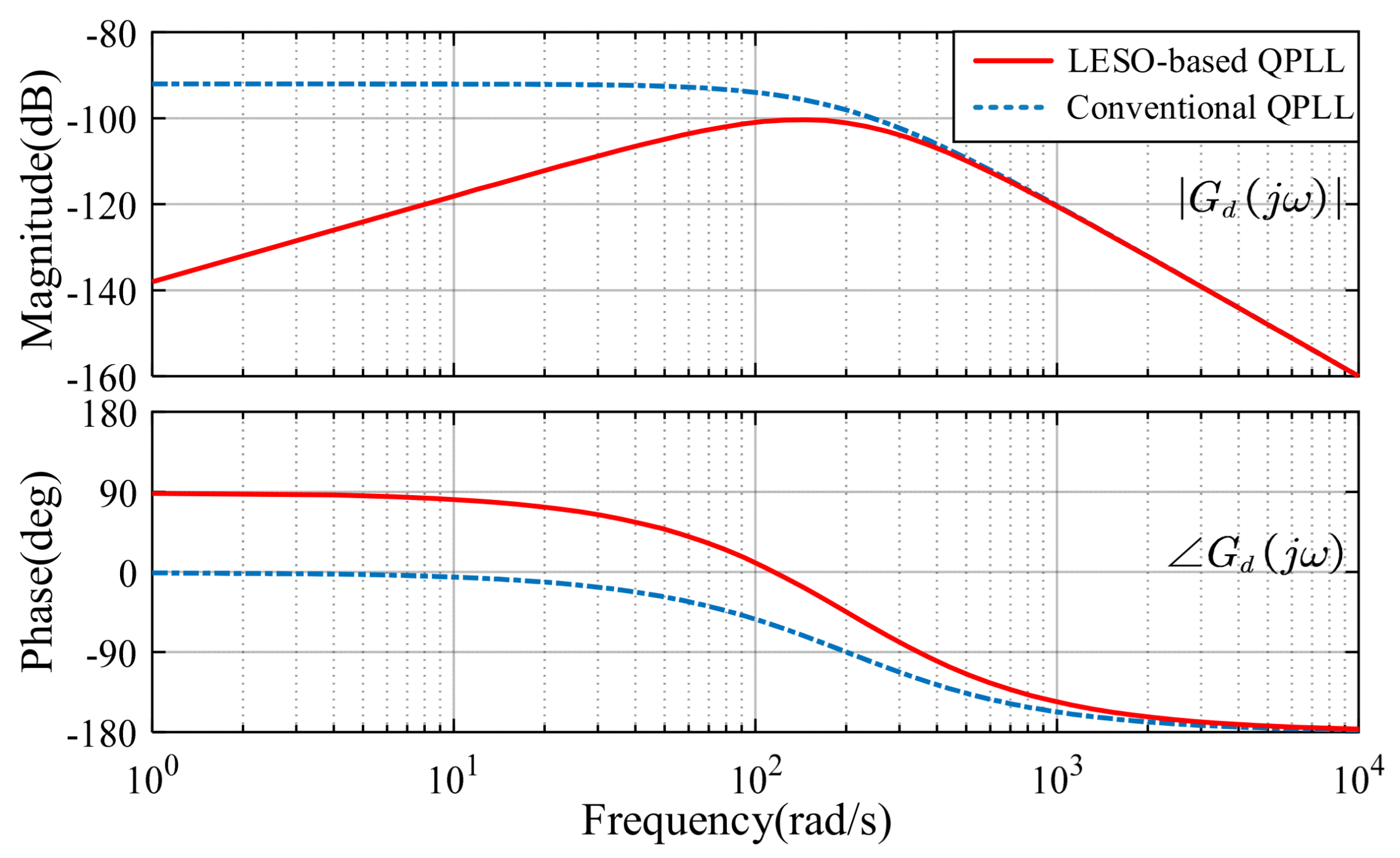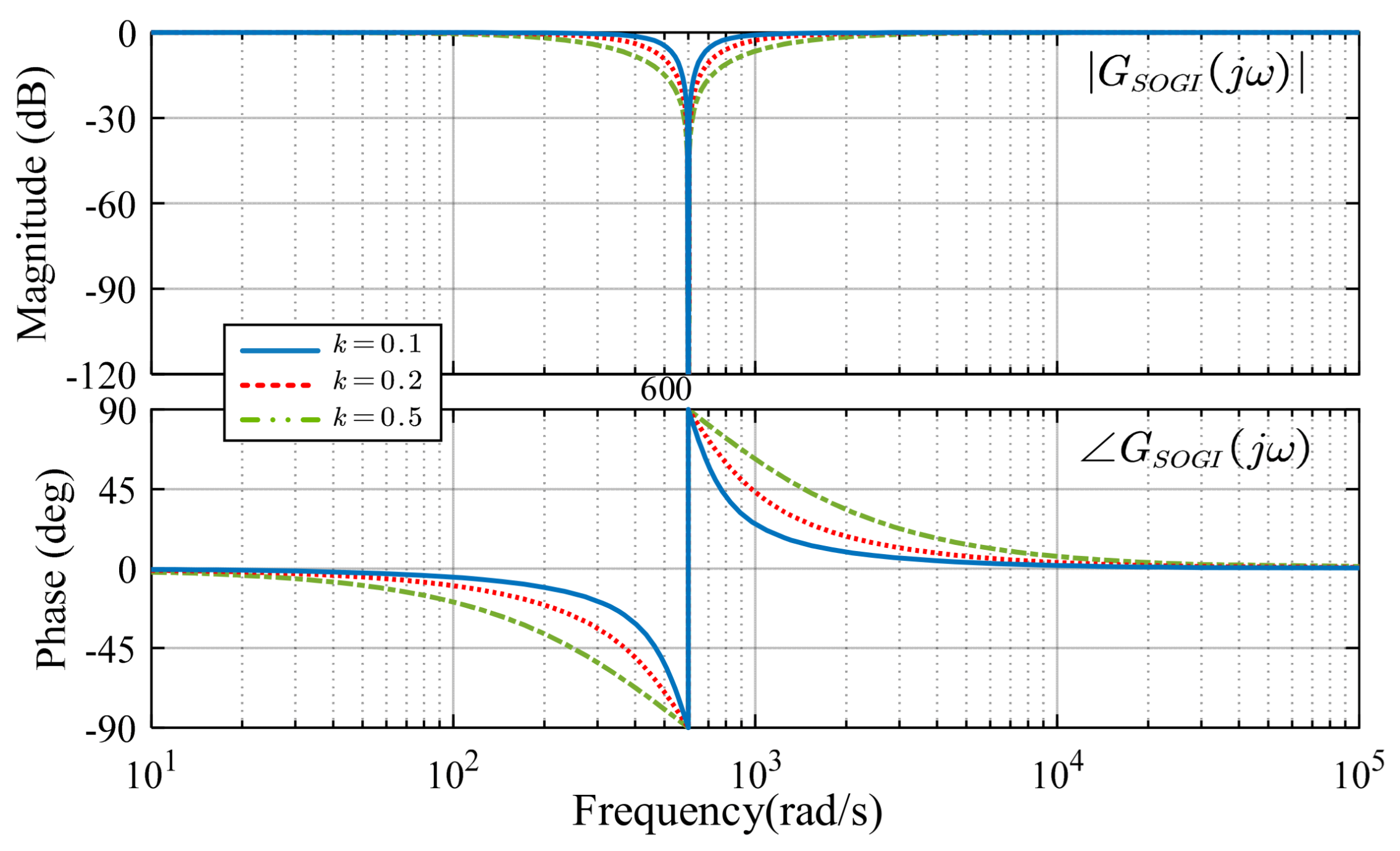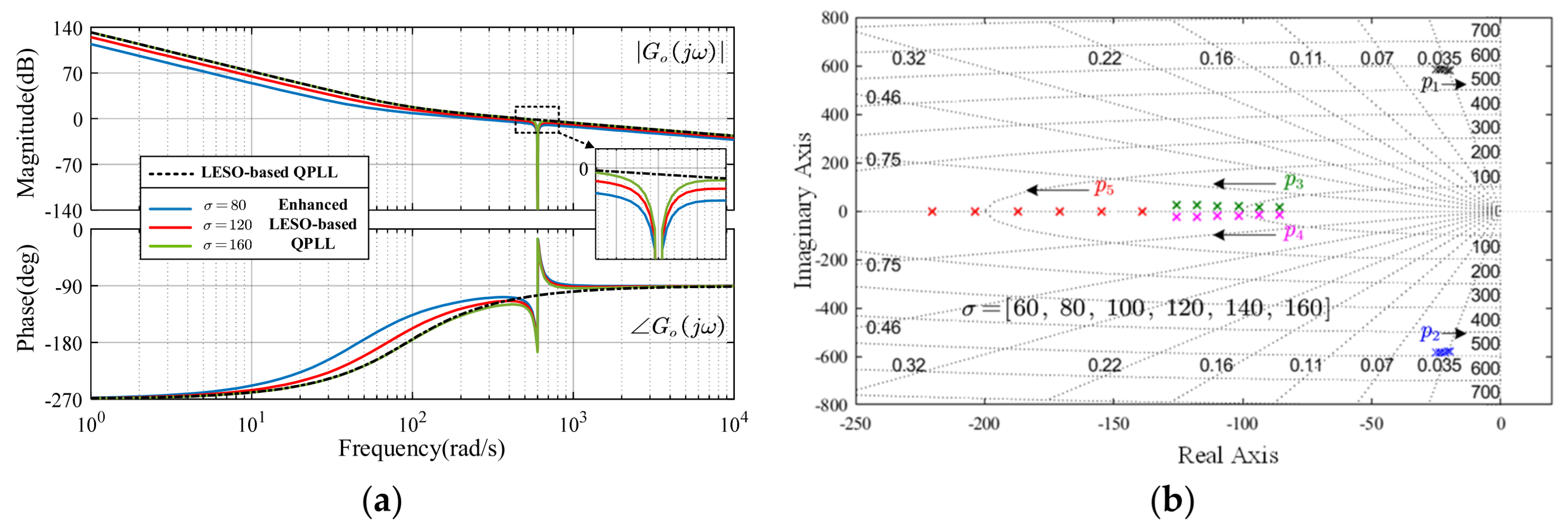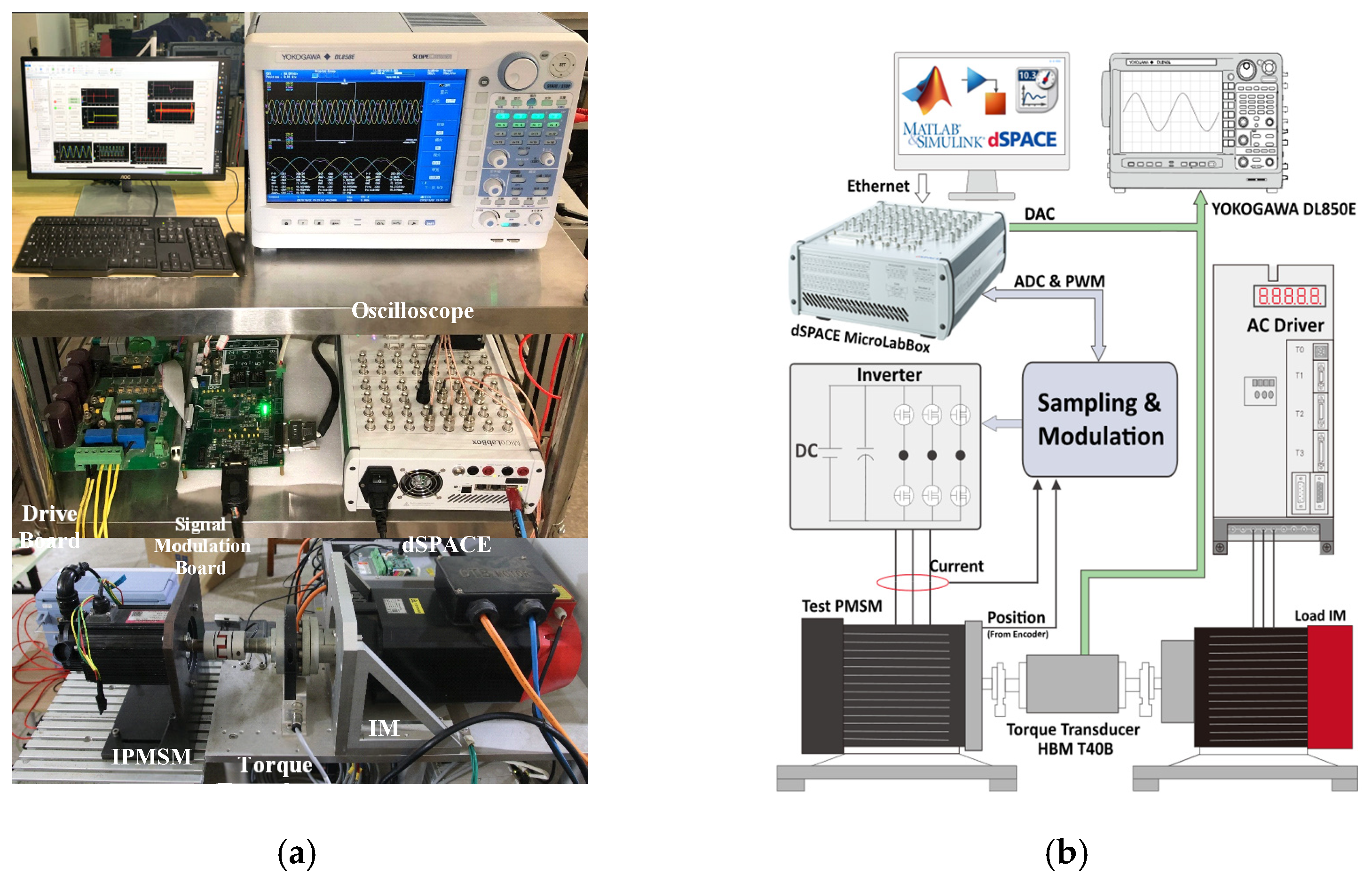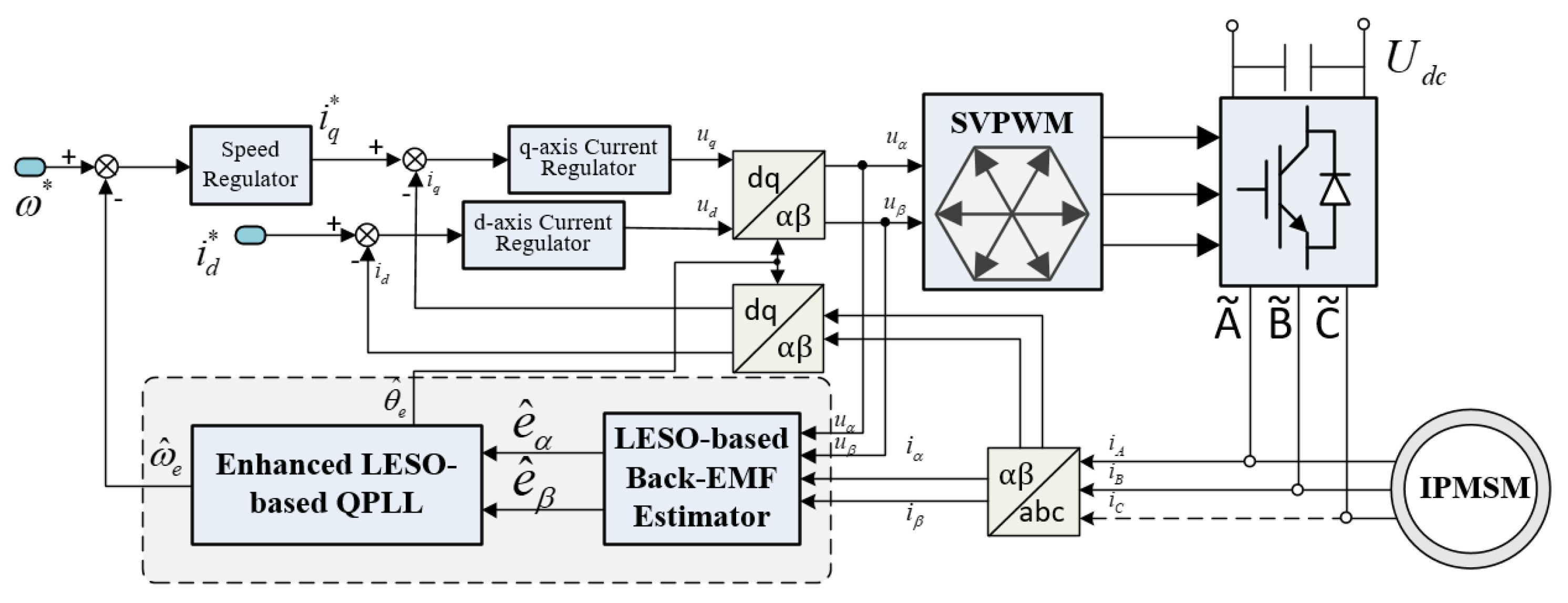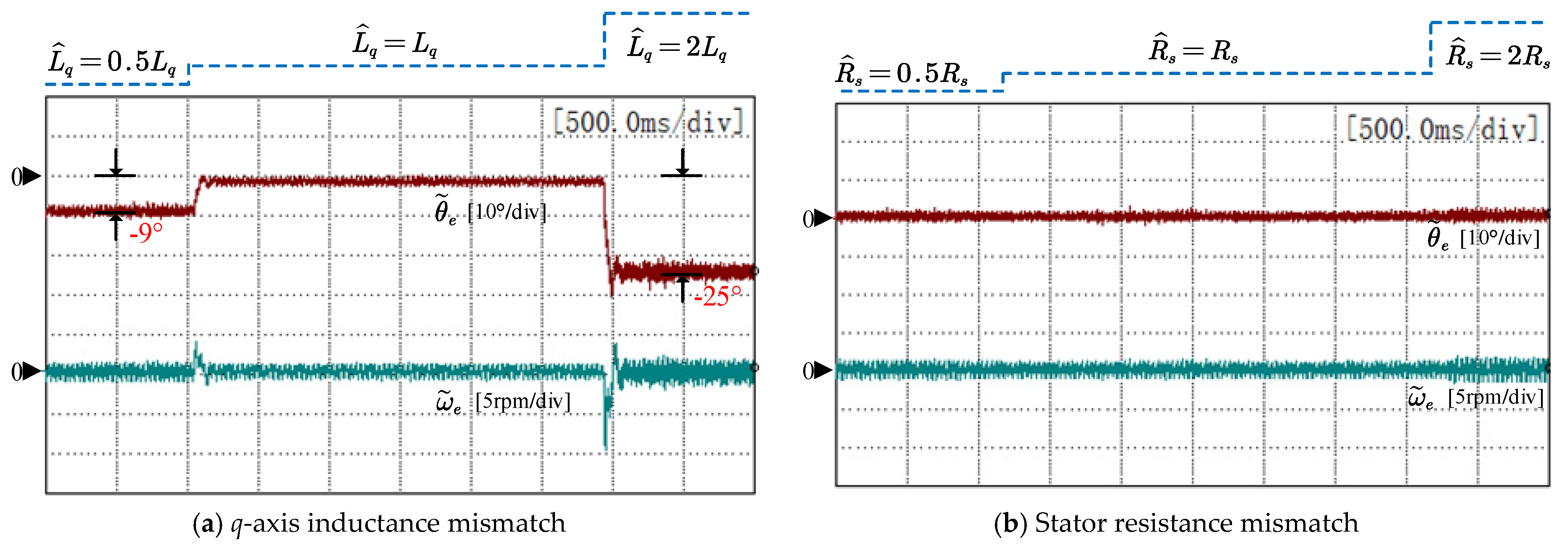1. Introduction
In recent years, interior permanent magnet synchronous motors (IPMSMs) have been widely applied in household and industrial applications owing to the advantages of high efficiency, high torque density, and good dynamic response [
1]. In the typical field-oriented control (FOC) topology of an IPMSM drive, the rotor position information is the key to the accurate control of the motor’s torque and speed. Commonly, a position sensor mounted on the shaft of the motor is adopted to measure the rotor position, which not only increases the cost and size, but also reduces the system’s reliability. Therefore, it is of great significance to develop position sensorless control techniques that enable cost-effective system design, as well as provide reliable estimation of the position for the IPMSM drives.
IPMSM sensorless control methods are commonly divided into two types according to the physics principle. The first type is the high-frequency signal injection (HFI)-based methods [
2,
3]. The second type is the model-based methods [
4,
5,
6,
7,
8,
9,
10,
11,
12,
13,
14,
15,
16,
17,
18,
19,
20,
21]. In the medium-speed and high-speed operating ranges, the model-based methods hold a dominant role among various kinds of sensorless control methods. The typical topology of model-based method comprises of two parts. The first part is a back-EMF estimator, which extracts the back-EMF from the voltage and current information. The second part is a position/speed estimator, which extracts the position and speed information from the estimated back-EMF. Currently, a large number of methods have been proposed to estimate the back-EMF, for example, the disturbance observer [
4,
5], the sliding-mode observer (SMO) [
6,
7,
8], the model reference adaptive system (MRAS) [
9], and the extended Kalman filter (EKF) [
10] [
11,
12].
Recent years have witnessed great development and increasing applications of active disturbance rejection control (ADRC) theory in the motor control and power electronics fields [
22,
23,
24]. As the core of ADRC, the extended state observer (ESO) shows great prospects in the sensorless control field of IPMSMs. The main characteristics of the ESO is that the unknown internal disturbance together with the external disturbances are considered as the total disturbance. Then, the total disturbance is formulated as an extended state, which will be estimated by the ESO [
25]. As the system errors induced from the sampling error, parameter variation, and other model uncertainties are all incorporated into the total disturbance, the robustness of this observer will be remarkable. At present, dozens of studies have proven its effectiveness in states and disturbance estimation [
26,
27,
28].
Currently, the ESO is being increasingly applied in the sensorless control field of PMSMs [
13,
14,
15,
16,
17]. In [
13], a linear ESO (LESO) was adopted to estimate the back-EMF of an IPMSM. In [
14], a sinusoidal interference estimator was inserted into the disturbance estimation loop of the LESO to achieve accurate estimation of the back-EMF under limited bandwidth. In [
15], an enhanced LADRC for a sensorless IPMSM drive was proposed. The enhanced LADRC consisted of two cascaded LESOs; one was designed to estimate the back-EMF by treating it as the external disturbance, and the other one was designed to estimate the internal disturbance such as parameter mismatch. In [
16], a linear-nonlinear switching ESO was proposed to improve the convergence rate as well as maintain the estimation accuracy of the back-EMF.
Regardless of what kind of back-EMF estimator is chosen, it is necessary to extract the rotor speed and position from the estimated back-EMF at the next stage of sensorless control. The arctangent function can be used to directly calculate the position [
13], and the speed is calculated from the derivative of position. However, the derivative operation will bring unexpected noise to the system. The quadrature phase-locked loop (QPLL) is a better alternative for speed/position estimation [
4,
6,
8,
14,
15,
16,
17,
18,
19,
20,
21,
22,
23,
24,
25,
26,
27,
28,
29]. The QPLL contains a proportional-integral (PI)-type loop filter, which helps to achieve zero steady-state error in tracking the DC signal. Currently, the QPLL has been extensively utilized in IPMSM sensorless control owing to its easily tuned gains and simple structure. However, the following drawbacks still exist that limit the overall performance of the sensorless control system [
30,
31]:
- (1)
The second-order form makes it incapable of tracking ramp speed with zero steady-state error. Therefore, the performance of the sensorless control system will suffer from noticeable degradation during accelerating or decelerating operation.
- (2)
Limited closed-loop control capability when dealing with fast-varying external disturbance. The internal PI regulator will cause unexpected overshoots. Therefore, a sudden external disturbance will bring significant error to the estimated speed and position.
- (3)
Unable to suppress sinusoidal disturbance. In practical applications, due to the existence of inverter nonlinearities, the estimated back-EMF will contain distinct fifth- and seventh-order harmonics [
12]. Hence, the position error in the forward path of the QPLL contains sixth-order harmonic fluctuations. Consequently, the estimated position and speed will contain sixth-order harmonic fluctuations as well.
To overcome the above drawbacks of the conventional PI-type QPLL, a more efficient estimator should be adopted to replace the PI regulator in the QPLL. In fact, the ESO, with its unique advantages in handling disturbance and uncertainties, is a competitive candidate for speed and position estimation.
Therefore, in this article, a static-errorless position estimation method based on the LESO is proposed. Two second-order LESOs are designed to estimate the α- and β-axis back-EMFs. A third-order LESO is incorporated into the QPLL to enhance the position tracking performance and the robustness against external disturbance. To achieve static-errorless position estimation, the proposed LESO-based QPLL is improved from two aspects. On the one hand, the DC position estimation error induced from the phase lag of the back-EMF estimator is analyzed and compensated. On the other hand, to suppress the position harmonic fluctuations induced from the nonsinusoidal back-EMFs, a second-order generalize integrator (SOGI) is inserted into the feedforward path of the LESO-based QPLL.
The remaining parts of this article are organized as follows.
Section 2 gives a brief description of the LESO, and the LESO-based back-EMF estimator is designed.
Section 3 analyzes the existing drawbacks of the conventional QPLL, followed by the design of the LESO-based QPLL. To further diminish the position estimation error,
Section 4 proposes an enhanced LESO-based QPLL. The experimental results are presented in
Section 5. Finally, the conclusions are drawn in
Section 6.
3. Design of the LESO-Based QPLL
According to Equation (8), the estimated equivalent back-EMF contains the rotor position information. By adopting a properly designed QPLL, the rotor position and speed information can be extracted from the estimated back-EMF, thereby achieving closed-loop sensorless control of the IPMSM.
3.1. Conventional QPLL
The typical structure of a conventional QPLL is shown in
Figure 1. It consists of three parts: a phase detector (PD), a PI-type loop filter (LF), and a voltage-controlled oscillator (VCO). The QPLL is designed to be a closed-loop structure, where the output phase can automatically synchronize with the input phase through closed-loop regulation. In
Figure 1, a phase detector is applied to extract the input phase information from the estimated back-EMFs. However, according to Equation (8), the magnitude of the estimated back-EMF varies with the rotor speed. Thus, the QPLL will show different frequency responses at different speeds. To deal with this problem, the back-EMF normalization method is commonly adopted [
29], which helps the QPLL to maintain consistent frequency response at different operation speeds.
The output of the phase detector in
Figure 1 is expressed as:
After normalization, the transfer function of QPLL is expressed as:
where
and
are the proportional and integral gain, respectively. By placing the two poles of Equation (14) at the same point on the left real axis of the complex plane, the gains can be tuned as:
where
denotes the bandwidth of the QPLL. A larger
indicates a faster tracking rate; meanwhile, it introduces more noise to the estimation result.
With a well-tuned bandwidth, the QPLL can provide accurate estimations of position and speed during steady-state operation. However, due to the fundamental limitations of the PI regulator, it is still challenging for the conventional QPLL to provide reliable estimation during transient-state operation. For example, the QPLL cannot achieve zero estimation error when tracking ramp speed [
14]. In addition, the limited anti-disturbance capability will bring unexpected overshoots to the estimation results when the system encounters fast-varying external disturbance. Therefore, to improve the overall performance of the sensorless control system, it is necessary to develop a more efficient position estimator.
3.2. Design of LESO-Based QPLL
Owing to the unique disturbance estimation capability, the LESO can not only be used for back-EMF estimation, but also has the potential to facilitate the speed and position estimation. To achieve more accurate estimation under transient-state operation, the conventional QPLL is improved by replacing the PI regulator with a third-order LESO.
To construct the LESO-based QPLL, the mechanical motion dynamics of the IPMSM should be considered first:
where
is the number of pole pairs,
is the viscous friction coefficient (N·m·s/rad),
is the moment of inertia (kg·m
2),
is the load torque (N·m), and
is the electromagnetic torque (N·m). For the employed IPMSM,
is expressed as:
The key to the successful construction of a LESO is to reformulate the practical control plant to a cascaded integral plant and give out the definition of disturbance [
22]. The known and unknown disturbance for system (16) can be defined as:
where
is the torque reference;
is the unmodeled dynamics and noise;
and
denote the known disturbance and the unknown disturbance, respectively;
denotes the estimated rotor speed.
The known disturbance represents the disturbance that can be directly or indirectly obtained. The unknown disturbance represents the disturbance that cannot be acquired. Obviously, , , and are unmeasurable in the sensorless control system. In addition, consists of the load torque term and the difference term between and . Therefore, the load torque fluctuation and the sudden speed variation will both be considered in the disturbance model.
Then, a third-order LESO for system (18) can be designed by regarding the unknown disturbance
as an extended state:
where
,
, and
are, respectively, the estimations of
,
, and
;
is the position estimation error;
,
, and
are the observer gains. By setting the bandwidth of the LESO to
, the observer gains are tuned as:
Figure 2 shows the block diagram of the proposed LESO-based QPLL. It should be noted that the error obtained from the phase detector is
. However, the estimation error of the LESO is defined as
. Therefore, a unit negative gain is inserted into the block diagram.
3.3. Comparison between the Conventional QPLL and the LESO-Based QPLL
3.3.1. Comparison of the Tracking Performance
Transforming Equation (19) into the frequency-domain, the following transfer functions can be derived:
where
is the characteristic polynomial of the LESO:
Then, the position tracking error of the LESO-based QPLL can be expressed as:
Meanwhile, according to (14), the position tracking error transfer function of the conventional QPLL is written as:
To evaluate the tracking performance of the conventional QPLL and the LESO-based QPLL, three typical reference signals are given: the step position, the step speed, and the ramp speed. The reference signals in the frequency domain are respectively expressed as:
where
,
, and
are the position amplitude, the speed amplitude, and the acceleration amplitude of the reference signals, respectively. Then, by applying the final value theorem:
the steady-state position tracking error of the two QPLLs can be obtained, as shown in
Table 1. It can be found that the position error of the conventional QPLL cannot converge to zero when tracking the ramp speed reference. The error can be reduced by increasing
, but this will increase the overshoots during transient-state operation. As for the LESO-based QPLL, it achieves zero tracking error for the three reference signals. Therefore, it has better tracking performance than the conventional one.
3.3.2. Comparison of the Disturbance Rejection Capability
According to the mechanical motion dynamics of the IPMSM shown in Equation (16), a sudden variation in the external load torque will bring a disturbance to the rotor speed. If the rapidly changing speed goes beyond the bandwidth of the estimator, obvious speed and position estimation errors will occur. To facilitate the subsequent analysis, the torque disturbance is regarded as an acceleration disturbance
d(
t), the unit of which is m/s
2. According to Equation (21), the influence of the acceleration disturbance on the estimated position of the LESO-based QPLL can be described by the following transfer function:
For the conventional QPLL, the disturbance is not shown in
Figure 1. However, as such a disturbance is an acceleration disturbance, it can therefore be modeled into the QPLL, as shown in
Figure 3.
Then, the influence of the acceleration disturbance on the estimated position of the conventional QPLL can be described by the following transfer function:
The disturbance rejection capability of the conventional QPLL and the LESO-based QPLL is compared in
Figure 4, where the Bode diagrams of
and
are illustrated. The bandwidth is set to
rad/s. Thus,
,
,
,
, and
. It can be found that the LESO-based QPLL has a better disturbance rejection capability compared to the conventional one, especially in the low-frequency range. Therefore, the LESO-based QPLL can provide a more reliable estimation of position under the influence of the external load torque disturbance.
5. Experimental Verification
In this section, the effectiveness of the proposed IPMSM sensorless control method is verified through experimental study. The photo and the diagram of the experimental platform are demonstrated in
Figure 10. During the experiment, the test IPMSM is driven by an inverter. The parameters of the IPMSM are given in
Table 3. An induction motor coupled with the test IPMSM provides the load torque. The proposed control algorithm is ran on the dSPACE real-time platform. An optical encoder mounted on the shaft of the rotor is utilized to obtain the real position, which is merely for comparison purposes.
The block diagram of the IPMSM sensorless control system is shown in
Figure 11. In the following experiments, the PWM switching frequency is set to 5 kHz. The DC-link voltage is set to 200 V. The deadtime of PWM is set to 4 μs. The whole algorithm is tested under the field-oriented control (FOC) structure with
. A simple
I-f-based open-loop start-up method in [
33] is utilized for start-up purposes and the system is switched to closed-loop sensorless operation at 100 rpm. The gains for speed loop PI regulators under sensorless control are set to
and
. The gains for
d- and
q-axis current loop PI regulators are set to
,
, and
, respectively. The bandwidth for the LESO-based back-EMF estimator is set to
rad/s. The bandwidth for the conventional QPLL and the enhanced LESO-based QPLL are both set to
rad/s. The parameter for the SOGI is set to
.
5.1. Verification of Steady-State Performation
5.1.1. Steady-State Performance of the Sensorless Control System with the Conventional QPLL
Figure 12 shows the experimental results of the estimated back-EMF, the estimated position, and the position estimation error under no load. The back-EMF is estimated by the LESO-based back-EMF estimator, and the position is obtained by the conventional QPLL. As can be seen in
Figure 12a,b, the position error contains sixth-order harmonic fluctuations. The magnitude of the fluctuation at 300 rpm is around 2°, which is larger than that at 1500 rpm. This is because the magnitude of the back-EMF is proportional to the speed; thus, the voltage distortion caused by inverter nonlinearities plays a more significant role at low speed. Then, the position error harmonics is more significant at low speed.
In
Figure 13, the IPMSM is operating under rated load (5 N·m). It is obvious that the harmonic content of the estimated back-EMF is much more significant than that under no load. As a result, the position harmonics is also much more significant. The position error fluctuates six times in one electric position period, and the magnitude is about 6.5° at 300 rpm and 2° at 1500 rpm. In addition, it should be noted that the DC error of the position is around −5° at 300 rpm and −22° at 1500 rpm. This is because the estimated back-EMF lags behind the actual one. Then, the resulting estimated position will lag behind the actual one as well. According to above experimental results, it can be seen that the conventional QPLL is not capable of providing reliable estimation of the position in practical application.
5.1.2. Sensorless Operating at Different Speeds
In
Figure 14, the experimental results of the sensorless control system with the conventional QPLL and with the enhanced LESO-based QPLL at different speeds are presented and compared. The test machine operates under no load, and the speed command is set from 300 rpm to 1500 rpm at intervals of 300 rpm. As can be seen in
Figure 14a,b for the conventional QPLL, the DC content of the position estimation error increases with the speed. However, for the enhanced LESO-based QPLL, the DC content of the position estimation error is within 2° during the wide-speed range.
In
Figure 15, the experimental results of the two methods are compared under rated load. It can be seen that the fluctuations in position error and speed error using the proposed method are significantly smaller than those with the conventional method. Therefore, the effectiveness of the enhanced LESO-based QPLL in steady-state operation is verified.
5.2. Verification of Transient-State Performance
In
Figure 16, the experimental results of the sensorless control system with the conventional QPLL and with the enhanced LESO-based QPLL under step load torque disturbance are compared. The command speed of the test machine is set to 300 rpm. The load machine provides a step load torque from rated load (5 N·m) to no load. During the off-load transient, the maximum position estimation error of the conventional QPLL reaches up to 75°, and the maximum speed estimation error reaches up to 20 rpm. However, the maximum position error of the enhanced LESO-based QPLL is less than 18°, and the maximum speed error is only 5 rpm.
Figure 17 presents the experimental comparison of the two methods under step load torque disturbance at 1500 rpm. The maximum position error and speed error are, respectively, 8° and 5 rpm for the conventional QPLL. However, for the enhanced LESO-based QPLL, the maximum position error and speed error are, respectively, 5° and 2 rpm. According to the experimental results, it can be concluded that the proposed method has better robustness against the load torque disturbance.
5.3. Influence of Parameter Mismatches
The steady-state performance and the transient-state performance of the proposed enhanced LESO-based QPLL has been verified in above experiments. In this experiment, the influence of q-axis inductance and stator resistance mismatches on the proposed sensorless control method is investigated.
Figure 18a,b, respectively, show the experimental results with
q-axis inductance mismatch and stator resistance mismatch at 300 rpm under rated load. During the experiment, the parameter changes from 50% nominal value to 200% nominal value. As can be seen in
Figure 18a, the position error is about −9° when
and −25° when
, while the speed error is nearly the same during the whole process. In
Figure 18b, the position error and speed error remain almost unchanged even though
increases from
to
.
Figure 19 shows the experimental results at 1500 rpm. In
Figure 19a, the position error is about −12° when
and −40° when
, while the speed error is nearly the same during the whole process. In
Figure 19b, the position error and speed error remain almost unchanged even though
increases from
to
.
From above results, it can be concluded that the proposed sensorless control method has strong robustness against resistance mismatch. However, q-axis inductance mismatch will bring significant errors to the estimated position, especially at high speed. In addition, as the back-EMF estimator does not require the information of d-axis inductance, this method obviously has strong robustness against d-axis inductance mismatch.
6. Conclusions
To improve the transient-state performance, as well as the steady-state performance of the IPMSM sensorless control system, this article proposes a static-errorless rotor position estimation method based on the LESO. Two second-order LESOs are utilized to estimate the α-β axis back-EMFs. A third-order LESO is incorporated into the QPLL to enhance the position tracking performance and the robustness against external disturbance. Then, considering that the nonideal back-EMF will bring DC and harmonic fluctuation errors to the estimated position, an enhanced LESO-based QPLL with static-errorless rotor position estimation is proposed. On the one hand, the DC position estimation error caused by the phase lag of the back-EMF estimator is analyzed and compensated. On the other hand, to suppress the position harmonics induced from the nonsinusoidal back-EMFs, a SOGI is inserted into the feedforward path of the LESO-based QPLL. The experimental results show that compared to the conventional method, the proposed method achieves better position estimation performance both in transient-state and in steady-state operation. During steady-state operation, the fluctuation in the estimated position using the proposed method is reduced to 1°. During the acceleration transient, the DC error of the estimated position does not exceed 2°. In addition, when encountering a large load torque disturbance at 1500 rpm, the maximum speed variation is reduced from 67 rpm to 40 rpm.
The improved sensorless control method proposed in this article is only applicable in middle- and high-speed ranges. In the low-speed range, the HFI-based method is commonly adopted. As the HFI-based method normally contains a PI-type position estimator, it will also encounter problems such as unexpected overshoots and a limited disturbance rejection capability. In our future research, we will consider introducing the proposed third-order LESO into the HFI-based method so as to improve the low-speed operation performance.
